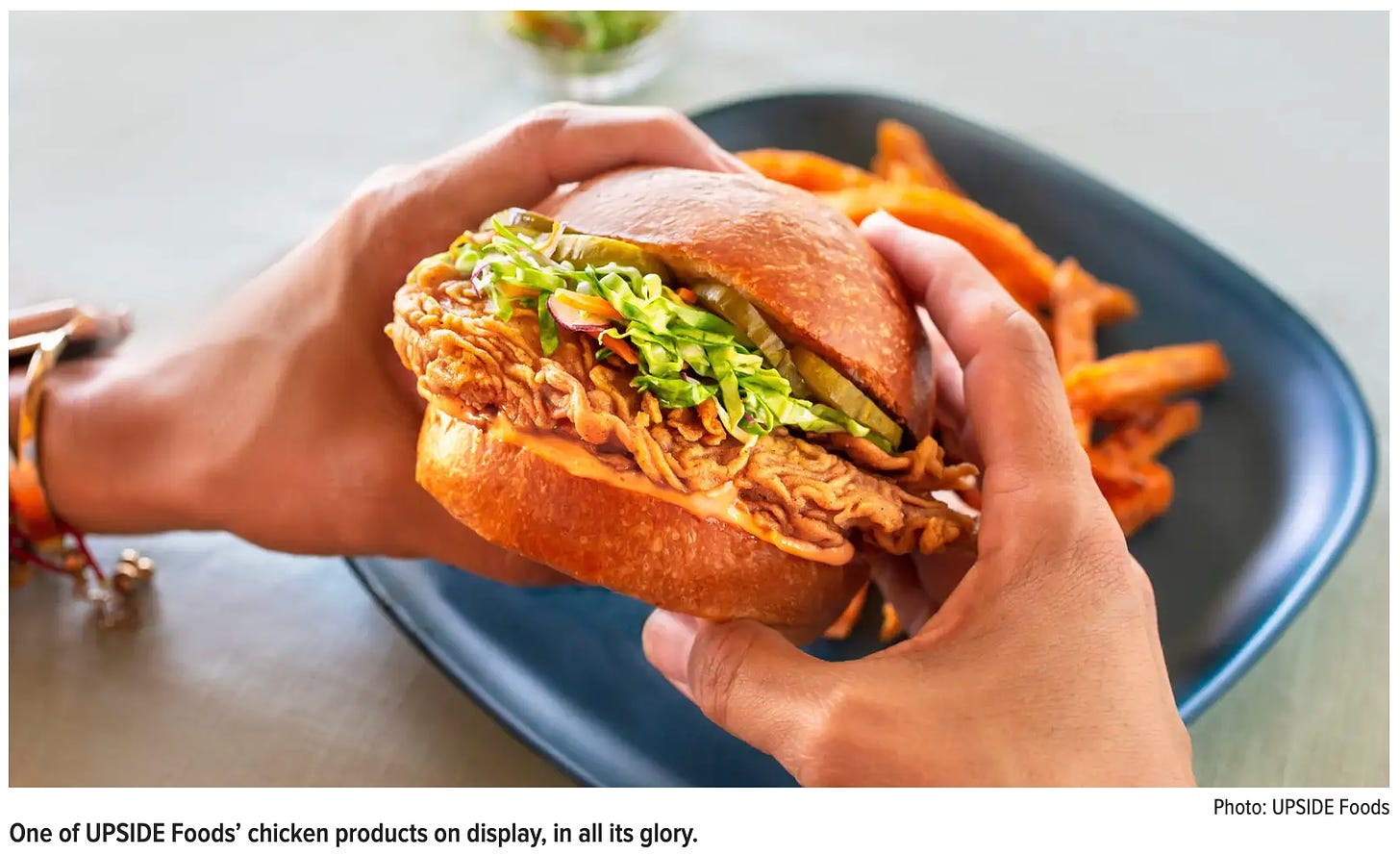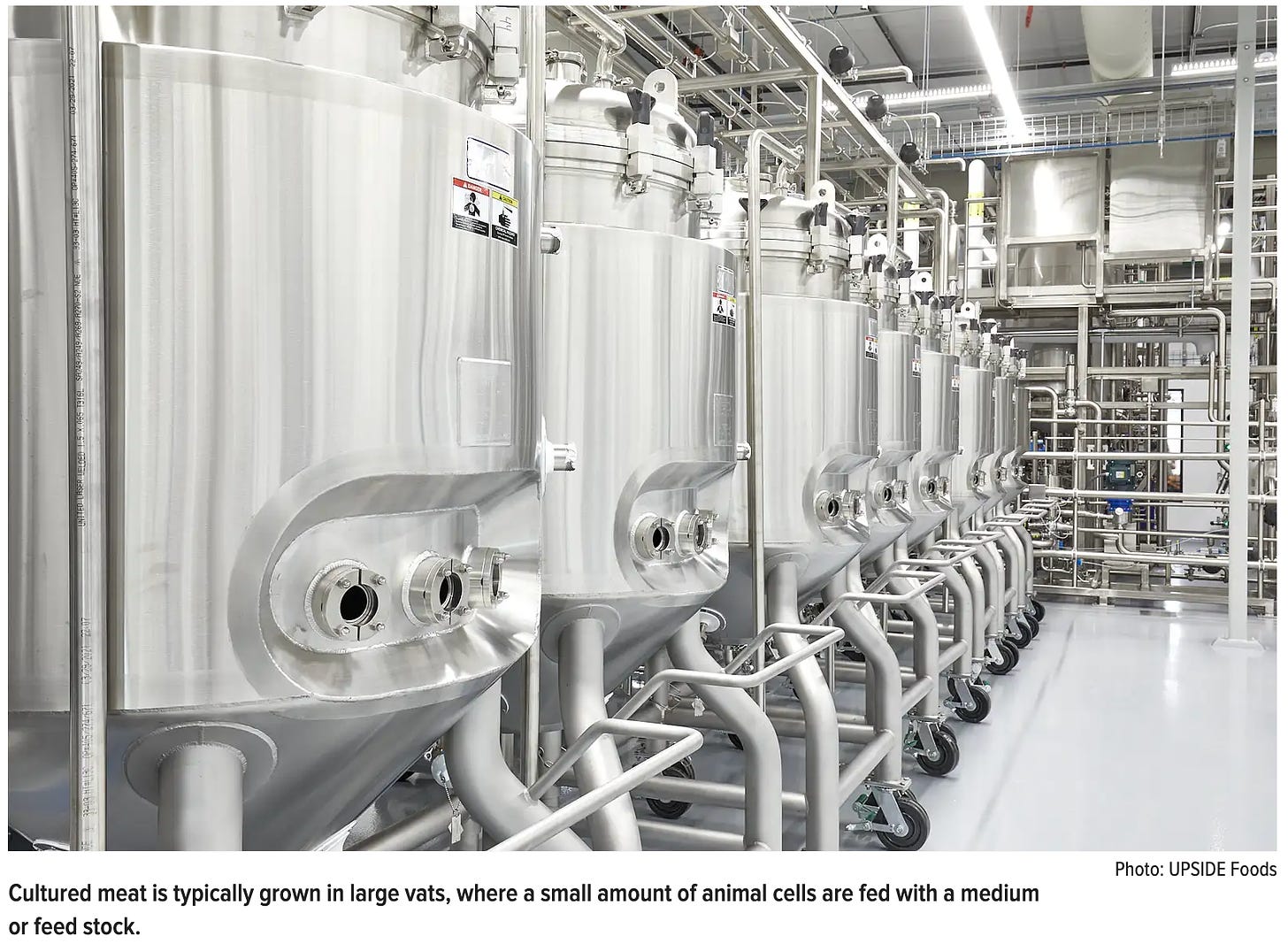Because we’re all probably sick of turkey by now….
By now, we’ve probably all heard of things like Beyond Meat, Impossible Burgers, and the like. Some of these products, while not made FROM meat, have come close to tasting LIKE meat. Some of them I like better than others, and some are a complete swing and a miss. One thing is for sure, though; they’re not like-for-like substitutes.
I tell people that if you bite into a Beyond Burger or equivalent expecting the taste of beef, you’ll be disappointed. It’s good, but it’s not a hamburger. Perhaps over the next few years, companies making these products will get closer to that like-for-like taste, but that seems a ways down the road.
But what if you could get meat that tasted like chicken or beef because it was grown from chicken or beef? What if you could grow that meat in a lab with just a few actual cells, leaving the rest to science?
It seems food science has progressed to the point where we’re on the precipice of doing precisely that.
Lab-grown meat is one big step closer to grocery store aisles and your dinner plate. The Food and Drug Administration announced its first-ever rubber stamp for a cultured meat company on Wednesday. UPSIDE Foods completed the FDA’s pre-market consultation process, and the agency found no reason to doubt the company’s safety claims.
Though technically not an “approval process” the FDA’s assessment of UPSIDE amounts to a green light for the company’s technology and production method, which uses small amounts of chicken cells + a growth medium to culture larger quantities of meat, minus the slaughter.
The FDA as yet has no conventional approval process for what UPSIDE does, but they have closely monitored the company’s work. And what they’ve seen so far leads them to believe that the product is safe for human consumption.
That doesn’t mean you'll see UPSIDE’s cultured meat on store shelves this week, but the FDA’s enthusiasm is a good sign.
“We have no questions at this time regarding UPSIDE’s conclusion that foods comprised of or containing [its] cultured chicken cell material...are as safe as comparable foods produced by other methods,” the FDA wrote in its letter to the company—which is a clunky way to say: ‘sure, looks good.’
Cultured meat has been hyped up for years as a potential solution for the multitude of environmental downsides of standard, animal-made meat. Though some studies have called into question the actual environmental benefits of lab-grown steaks, filets, and drumsticks, the reality is it’s hard to measure the relative climate and pollution costs while “meat minus animals” has stayed mostly theoretical.
The process behind cultured meat sounds like a chemistry project from Gremlins, only without the “Whatever you do, don’t feed them after midnight!” precaution.
It’s pure science, and the process is reminiscent of making beer, whiskey, or wine- it’s all chemistry.
Companies have been vying for regulator approval of cultured meat in the U.S. for a long time, to no avail. Without the FDA’s blessing, no manufacturer has actually started producing their product at marketable scale. There are lots of different environmental considerations involved in accurately determining a food’s impact.
In the case of cultured meat, important factors like the land used to grow the grains included in cell growth medium and the energy needed to run these facilities are big question marks. Lots of varying estimates are out there, but until a company actually navigates those decisions and manages to make money—it’s hard to say how cultured meat’s environmental footprint compares to that of factory-farmed livestock.
Theoretically, cultured meat could be a massive boon for fighting climate change. Furthermore, with much less land needed for the feeding and grazing of cattle, that land could conceivably be used for better and more environmentally sound practices.
Of course, what’s less known are the environmental impacts of all the ancillary processes related to producing cultured meat. Figuring that out is part of determining how beneficial cultured meat can be. At first glance, it appears that cultured meat has the potential to create profound benefits in the fight against global climate change.
Because the meat and dairy industries, as currently constituted, are destroying our planet.
The world’s largest meat and dairy companies are responsible for more than 10% of all global methane emissions from livestock, with some singular companies emitting as much or more methane than many individual countries, including Russia, Germany, and Australia, a new report finds. The report, released this week from the Institute for Agriculture and Trade Policy and the Changing Markets Foundation, does a lot of math on food giants like JBS, Tyson, Nestle, and Danone, finding that just 15 meat and dairy companies are responsible for 3.4% of global methane emissions from human activity.
Overall, the report finds, these companies are emitting 734 million tonnes of CO2 equivalent each year—higher than the annual emissions of Germany—while their methane footprint from agriculture is around 80% of the European Union’s entire methane footprint.
Imagine what might be accomplished if we could cut those methane emissions by half. Of course, it’s conceivable that cultured meat could make this possible, though it’s challenging to pin down when that might happen. But the fact that it’s even a possibility is exciting. It lends some hope to a world awash in carbon and methane and with little impetus to reverse course.
And the worst part of this is that Earth appears to be suffering from- try not to laugh- cow burps:
Methane stays in the atmosphere for a much shorter time than carbon dioxide, but it’s more intense while it’s up there, making it an increasingly worrisome factor in the world’s runaway warming. Cows are a particularly problematic source of methane emissions due to the process of enteric fermentation—their digestive mechanics that result in some heavily greenhouse gas-laden burps. Thanks in part to the explosion of animal agriculture in recent decades, cattle farming is now responsible for 9% of total global methane emissions. In recent years, global leaders have increasingly stressed the need to get methane emissions under control, and quickly, in order to get overall warming down.
The truth is that all of us could do a lot of good if we could reduce our dairy and beef consumption by 10-25%. There’s more to it than that, of course, but when methane production from the dairy and meat industry represents 10% of the problem, why not start where we can do something about it? You and I aren’t going to fix emissions from smokestacks in China, India, or Russia, but we can eat less dairy and beef.
It might not seem like much, but it’s a start.
There are lots of industries that need more regulation to curb their methane emissions (looking at you, oil and gas companies). But as this report highlights, industrial agriculture has a large part to play in our current methane problem. The industry is also building defenses to its methane emissions that policymakers should be aware of as they construct responses.
What’s impressive about the report is how much data its authors could infer, given how little cooperation they received from major meat producers like JBS and Tyson. These companies don’t want to be known as methane producers, so they’re doing what they can to obscure the truth about their record.
In the meantime, cultured meat, though not from any American manufacturer, has been approved for sale in one country- Singapore. That took place in 2020. American manufacturers still have a ways to go before consumers see cultured meat in grocery store aisles or restaurants. Still, it’s possible that could happen in the not-too-distant future.
Well over a hundred companies are betting that lab-grown meat will be the future of food. What will that future look like? No one’s ready to say yet, but the amount of money bet on that future seems a sure sign that optimism is the order of the day. Moreover, many people think they’ve got an excellent chance to make a lot of money off cultured meat.
And they might not be wrong about that.








"Cultured meat" -- I've a picture of a roast sitting upright in bed with an open copy of The Riverside Shakespeare ...
I certainly look forward to the day when I can eat chicken &/or beef without guilt.